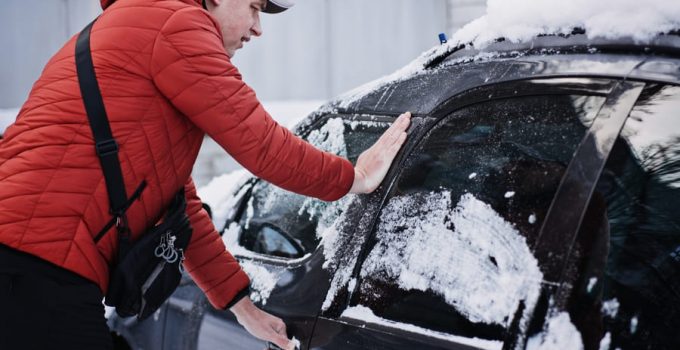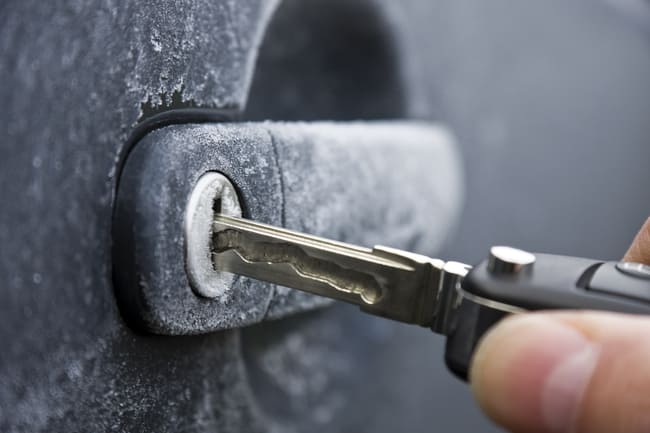
If you park your car outside overnight in winter and temperatures drop below zero in damp and wet weather, you may end up trying to open your door the next morning and failing. This is especially annoying if you have to rush to work or have an important appointment. But beware! Never attempt to force your car door open, as you can severely damage the rubber seals, causing your vehicle to leak. In this article we give you some tips on what you can do to prevent frozen car doors, what home remedies there are and what you can do to prevent them.
Contents
What are the causes of a frozen one Car door?
If you suddenly can no longer open your vehicle door in winter, can no longer put the car key in the lock or can no longer turn it in the lock, this is actually always because water or moisture has penetrated the door lock or the door seal and frozen there at minus temperatures. This happens, for example, when it rains or snows, but also when you wash your car, which is why you should take particular care in winter to only wash your car in warmer temperatures or to dry it well after washing.
However, before you try to force open the frozen car doors, you should first check what exactly is the reason that you can no longer open them. If you can still put the key in the lock without any problems, but then no longer turn it, you can assume that your car doors are frozen over. If you can't even put it in the lock, it's because your car's door lock is frozen. However, the latter hardly ever occurs anymore or rarely becomes a problem, since the majority of vehicles are now equipped with central locking and are unlocked by radio.
What helps with frozen car doors?
After you figure out exactly what's frozen, you can set about de-icing the door lock or door seal. It is very important that you proceed carefully in any case, as you can damage the rubber seal or even tear it off with excessive force. This would then have to be replaced in a workshop, which is not exactly cheap. You should also avoid using a hair dryer, as it gets extremely hot, which can severely damage the paintwork. In addition, a hair dryer is of little use, as the warm air cools down very quickly.
If your vehicle has central locking, a frozen door lock is rarely the reason why you can no longer open your door. But what can you do when your car doors are frozen?
The following tips can help you de-ice and ultimately open your door:
- First, press evenly on the door frame to break the ice. You can also tap lightly on the door panel. With a bit of luck, the door can then be opened.
- If that doesn't help, you can try opening another car door or the trunk to get inside the vehicle and force open the frozen car door from the inside. However, you should not drive off unless you can open the driver's door, as it must be possible to open it from the outside in the event of an accident.
- If you really can't open a door or if you can't open the frozen one from the inside, you can help yourself with warm water. This must not boil under any circumstances and be no more than 50 degrees warm to avoid damage to the paintwork. Make sure that you only pour the water to thaw the seal into the door gap and that it does not flow over the window pane, as in the worst case it can burst due to the high temperature difference. It is best to use a watering can with which you can dose the water well.
- You should then thoroughly dry the inside and the rubber seals of the door to prevent the door from freezing over again. The water on the floor should also be removed or covered with sand or loose gravel to avoid slipping.
What can I do against a frozen door lock?

There are three ways to de-ice a frozen car door lock. The simplest method is to spray a special de-icer on or in the lock. Under no circumstances should you keep this in the car, but in your apartment or in a bag so that you have it to hand if you need it. Alternatively, you can also use an alcohol-based disinfectant. Another option is to use an electric de-icer. This is a small, battery-operated pin that is inserted into the lock and uses heat to melt the ice. If you don't have any, a lighter can come in handy. This allows you to warm up your car key before you put it in the keyhole to defrost the lock. However, do not hold the lighter directly to the door lock to avoid damaging the paint and primer.
How can I prevent the car doors from freezing?
If you want to save yourself stress in winter and prevent your car doors from freezing over, you should winterize the rubber seals and door locks before the first frost. When caring for the seals, make sure that you use a grease or spray that is not water-based. Glycerin, milking fat, silicone spray or a special care stick from the car dealer are particularly suitable for this. This can prevent the seals from having direct contact with each other and sticking to each other.

For the door locks you should use graphite or a special care oil for car locks , for example WD-40. This displaces the moisture in the lock and effectively prevents freezing. However, common household cooking oil is not suitable, as it leads to blockages in the door lock due to increasing resinification.
You should also refrain from washing your car when the temperature is below zero. However, if this is necessary, make sure to thoroughly dry your car and especially the door seals. You can also tape the locks with tape to prevent water from getting in. Another preventative measure is to place a dehumidifier pad in your car to remove moisture from the interior air.
Are there home remedies for frozen car doors?
If you don't want to use chemical agents or don't have them at hand, you can also use various home remedies. One option is to lubricate the rubber seals with skin care lip balm or petroleum jelly. If the seals on your car door are already a bit brittle, you can also apply baby powder. The talc it contains ensures that the rubber becomes supple again. However, the powder must be applied very generously and regularly, as its effect does not last particularly long. If you also want to protect your door lock against freezing but don't have WD-40 or silicone spray with you, you can simply cover the lock with a plaster or adhesive tape if you leave your car outside overnight or for a longer period of time in sub-zero temperatures.
Conclusion
The cold season also poses a number of challenges for drivers, which can start with not even getting into the access the interior of their car. If you want to open frozen car doors, you should always be careful and do not use force to avoid damaging the seal. Warm, not boiling water is recommended as an aid. In order to prevent this annoyance, you should winterize the rubber seals and locks of your car doors in good time with the appropriate care.
